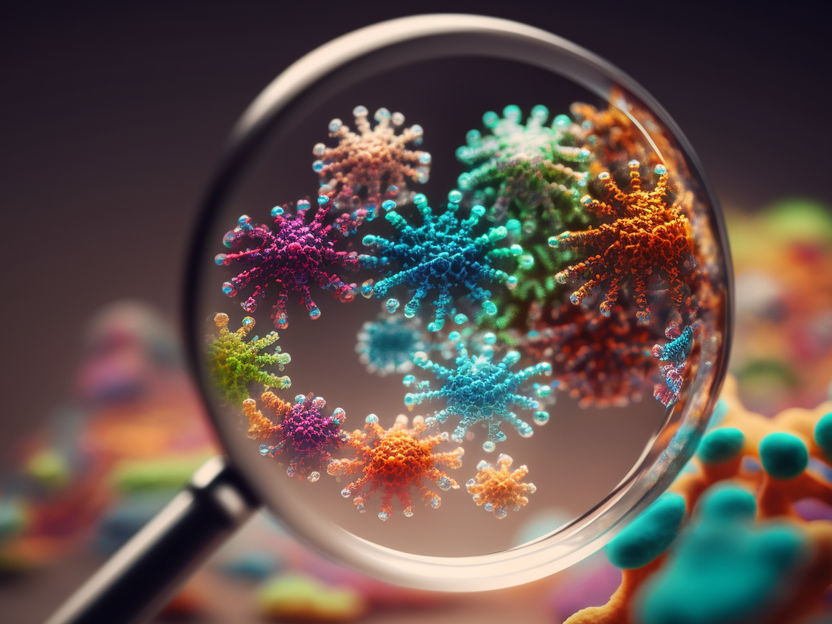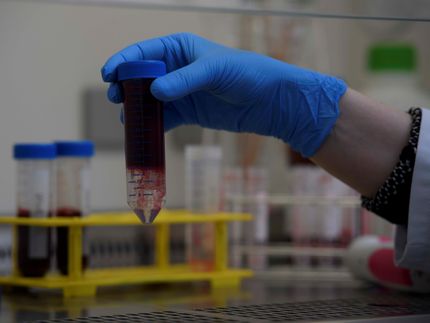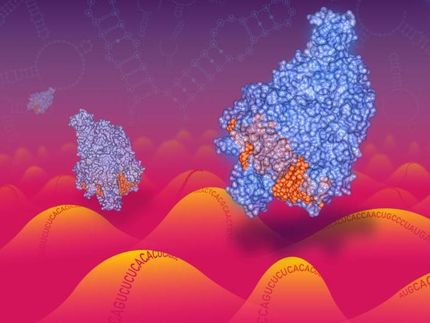New method for the detection of RNA viruses such as SARS-CoV-2
An effective and faster methodology than the PCR test
Experts from the University of Barcelona, the Institute for Advanced Chemistry of Catalonia (IQAC-CSIC), the Institute of Microelectronics of Barcelona (IMB-CNM-CSIC) and the Aragon Nanoscience and Materials Institute of Aragon (INMA) —a joint institute of the CSIC and the University of Zaragoza— have developed a new method to detect RNA viruses based on the triplex-forming probe technology. This innovative methodology opens up new options for detecting viruses such as SARS-CoV-2, the influenza A virus (H1N1) or the respiratory syncytial virus (RSV), a pathogen that affects newborn babies and requires careful differential diagnosis.

Symbolic image
Computer-generated image
This interdisciplinary study, published in the International Journal of Molecular Sciences, is led by Carlos J. Ciudad and Verónica Noe, from the Faculty of Pharmacy and Food Sciences and the Institute of Nanoscience and Nanotechnology (IN2UB) of the University of Barcelona; Ramón Eritja, Anna Aviñó, Lluïsa Vilaplana and M. Pilar Marco, from IQAC-CSIC and CIBER of Bioengineering, Biomaterials and Nanomedicine (CIBER-BBN); Manuel Gutiérrez, Antoni Baldi and César Fernández, from IMB-CNM-CSIC, and Valeria Grazu and Jesús Martínez, CSIC researchers at the Institute of Nanoscience and Materials and Aragón INMA (CSIC-UNIZAR) and the CIBER-BBN.
The study was carried out in the context of the PoC4CoV project, led by M. Pilar Marco and César Fernández and funded through the CSIC's Global Health Platform (PTI). The research study has continued as part of a project funded by La Marató de TV3 2020 to fight against COVID-19, in which experts from the Faculty of Chemistry of the UB also participate.
Polypurine hairpins to capture viral RNA
The new methodology is based on the ability of polypurine hairpins (PPRHs) —designed by the UB's cancer therapy group— to capture viral RNA and form a high-affinity triplex. When this hybrid structure is connected to a molecular probe and placed in contact with the sample from the affected patient, a detection signal of the viral agent is obtained. The method presented in the scientific publication is called the Triplex Enhanced Nucleic Acid Detection Assay (TENADA).
"PPRHs are unmodified single-stranded DNA hairpins consisting of two specular domains of antiparallel polypurines. These domains, connected to each other by a thymidine loop, are linked by intramolecular reverse-Hoogsteen bonds. The molecular hairpins can bind specifically to polypyrimidine sequences in single-stranded DNA (ssDNA), double-stranded DNA (dsDNA) or RNA viruses via Watson-Crick bonds, thus forming an antiparallel triplex", says Professor Carlos J. Ciudad, from the UB's Department of Biochemistry and Physiology.
An effective and faster methodology than the PCR test
An advantage in the detection of viral RNA is that the PPRH methodology can be applied without the intervention of reverse transcriptase —the enzyme that converts RNA to DNA— or the thermocycler (the device that amplifies samples of genetic material with the polymerase chain reaction or PCR). In addition, it has a sensitivity and specificity equivalent to that of the PCR test and can provide results in less than an hour.
As part of the study, the team used the sandwich hybridisation strategy in several biodetection devices. This strategy uses two oligonucleotides: a triplex-forming PPRH hairpin acting as a capture probe and a labelled duplex-forming DNA oligonucleotide acting as a detection probe.
"The triplex-forming PPRH hairpins were designed to bind to SARS-CoV-2 polypyrimidine sequences, while the detection probes were designed as complementary to a region close to the target site of the polypyrimidines. Thus, the presence of SARS-CoV-2 RNA is detected by the formation of the ternary complex on the biosensor’s surface", says Professor Verónica Noé (UB-IN2UB).
This methodology has been implemented in a compact electrochemical device that integrates a two-electrode electrochemical cell on a chip —manufactured in the IMB-CNM-CSIC Micro and Nanofabrication Clean Room— and a fluidic component on paper, and in a thermal lateral flow system implemented in nitrocellulose and using plasmonic nanoparticles and thermal paper which has been developed at INMA (CSIC-UNIZAR).
TENADA: applications in biomedical research
PPRHs are described in the scientific literature as tools for gene silencing of several genes mainly involved in cancer. In addition, they have also been incorporated as probes in biosensors for the detection of small RNA molecules (miRNA) to determine DNA methylation status and for the diagnosis of pneumonia caused by the fungus Pneumocystis jirovecii.
Now, the new TENADA methodology proves to be effective not only in the detection of viral particles. The high affinity of PPRHs for viral RNA is a property that can be applied to inhibit the virus replication process. For this reason, the antiviral properties of the polypurine hairpin clips CC1PPRH and CC2PPRH in cells of the VeroE6 lineage infected with SARS-CoV-2 virions are now also being studied.
Moreover, the work carried out by the different groups involved has also been the basis of a technology that was patented and licensed in July 2022 through the participation of the UB Patent Centre, the CSIC and the CIBER-BBN. In addition, this patent has been licensed on a non-exclusive basis to the Spanish company Nanoinmunotech through the management of the Bosch i Gimpera Foundation (FBG-UB) in the process of protecting the technology and the company's licensing agreement.























































